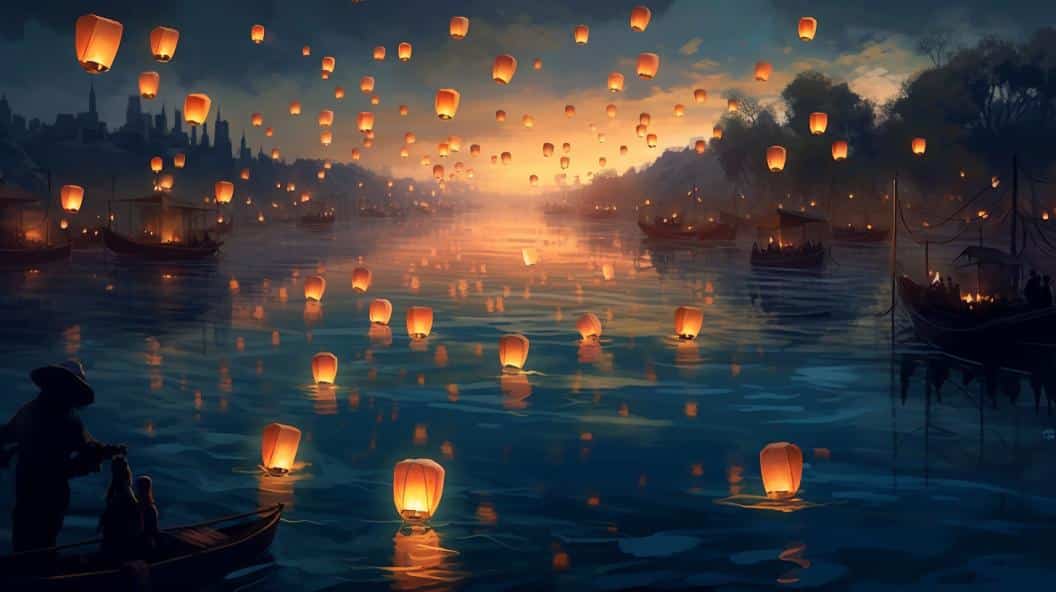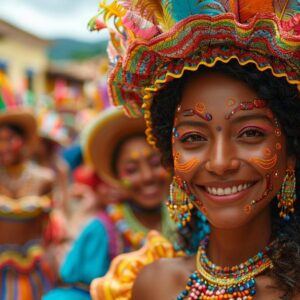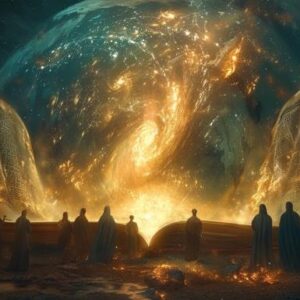Ever wondered how the twinkling lights of Diwali Indianize the sky or what fuels the fervent faith of Holy Week? On our fascinating journey through the multi-hued tapestry of sacred celebrations, we invite you to delve into the essence of important religious festivals and the cultural and spiritual rites that move souls around the globe. Discover the traditions that weave humanity into a single narrative of devotion and celebration. Join us on a path of discovery: the rituals, the chants, and the transcendental union that only religious festivals and traditions can invoke.
What are the main global religious festivals and their traditions?
Important religious festivals are an expression of the cultural richness and spiritual diversity that lie at the heart of countless traditions around the world. But, what characteristics define Hindu Diwali and how is it celebrated? Diwali, known as the Festival of Lights, is a vibrant celebration that symbolizes the victory of good over evil and is marked by rituals that include the lighting of lamps and the burning of fireworks. Families come together to share meals, exchange gifts and pray.
The duration of Diwali can vary, but it generally lasts five days and is one of the international religious celebrations that has transcended borders, being celebrated by Hindu communities around the world. The houses are meticulously clean and decorated, lights shine in every corner to welcome prosperity and good luck. The cultural and spiritual rites of this festival also include the practice of giving and receiving gifts and a spirit of renewal and forgiveness.
Moving to the Islamic context, how do Islamic Ramadan and Eid al-Fitr impact Muslim communities? Ramadan, the ninth month of the Islamic calendar, is a period of strict fasting from sunrise to sunset and is considered a time of deep reflection and prayer. In addition to being a pillar of Muslim practice, it contributes to strengthening family and community ties. After this month of sacrifice and devotion, Eid al-Fitr follows, a festival of joy and thanksgiving that includes community prayers, parties and the distribution of charity, a time to socialize with family and the community.
In the context of Christianity, how important are Catholic Holy Week and Christian Easter for the faithful? Holy Week, which culminates in Easter, is the holiest celebration in the Christian calendar. It recalls the passion, death and resurrection of Jesus Christ. Ceremonies are held throughout the week, with Palm Sunday, Good Friday and Hallelujah Saturday preparing for the culmination of the celebration, Easter Sunday. Easter eggs and parades are traditions associated with the event in several cultures, representing new life and hope.
The celebrations spread far beyond the borders of their countries of origin, and different communities around the world actively participate in these rites, full of symbolism and meaning. Access this link to explore more about the richness of festivities around the world and their meanings.
Religious festivals are a vivid reflection of the world's cultural and religious diversity, embedding deep historical, spiritual and social significance within the communities that celebrate them. They are not only reflections of religious beliefs, but also fuel tourism, education and cultural exchange, allowing visitors to delve into the diverse beliefs and traditions that shape different societies.
How do religious festivals influence tourism and education?
When major faith events happen around the globe, tourism flourishes in response. These events not only highlight faith and religious practices, but also bring with them profound cultural and educational beauty. A destination comes to mind when we talk about religious festivals in Brazil, like the Círio de Nazaré, where devotion combines with the opportunity to get to know a city in its entirety.
But what opportunities are generated by tourism during major global faith events?
During festivals like Diwali, Eid al-Fitr and Holy Week, cities and nations welcome a flood of curious pilgrims and tourists. These events generate temporary jobs, increase local businesses, and strengthen the regional economy. Religious tourism also opens doors to interfaith encounters, where visitors of different faiths can learn from each other in an environment of mutual respect and discovery.
And how is intercultural education promoted through festivals of ancestral traditions and rituals?
These festivals play a crucial role in promoting intercultural education. They serve as live books that teach history, customs and values. Through participating in rituals and ceremonies, or simply observing them, students and visitors gain an intimate understanding of the beliefs and practices that shape communities. Schools can align visits to these festivals with the curriculum, providing students with a practical understanding of topics covered in the classroom.
These festivals also bring historical traditions to life, which can inspire respect and interest among young people who may never have been exposed to them before. As they see the significance of ancient festivals unfold, they learn valuable lessons about living harmoniously in a multicultural society. Through the calendar of religious festivals, the rich framework of these traditions is preserved and transmitted, allowing a unique window into the diversity of the world's spiritual tapestry.
After all, when viewed up close, these events are a rich tapestry of tales of faith, resistance and community. They are not just moments of joy and celebration, but living lessons about how diverse beliefs have shaped and continue to shape our global societies. By promoting religious tourism and valuing intercultural education, we have a privileged view that allows us to observe not only what makes us different, but deeply, what unites us as human beings.
What challenges and measures are implemented to preserve religious festivals?
Religious festivals are vigorous manifestations of the world's cultural and religious plurality, interweaving historical, spiritual depth and social meaning in the communities that celebrate them. Such events have impacts that transcend faith, boosting tourism, education and cultural exchange, and allowing visitors to delve into the variety of beliefs and traditions that shape different societies.
As part of this complex landscape, festivals face significant challenges such as overcrowding and pressures on local resources. The Kumbh Mela, in India, illustrates this in a striking way: it is the largest religious event in the world, attracting millions of pilgrims. The pressures that this type of festival places on local resources include issues such as adequate water and food supply, basic sanitation and public safety.
Thinking about specific strategies to manage the environmental impact during religious celebrations, the festival of Ganesha Chaturthi, also in India, is emblematic. The traditional practice involves immersing Ganesha statues in water bodies, leading to environmental concerns related to water pollution and degradation. To address these impacts, local authorities and event organizers have employed measures such as creating biodegradable Ganesha statues and establishing artificial immersion tanks to prevent contamination of natural water resources.
Diversified celebrations around the world have specific approaches to combat the negative effects of large gatherings. These include crowd control measures, effective waste disposal and infrastructure upgrades to accommodate large human gatherings with the lowest possible impact. It is imperative to preserve these festivals not only to conserve cultural heritage but also to educate future generations about the diversity and relevance of global religious practices.
The community, a central element of these celebrations, promotes unity and continuity among participants, strengthening faith, connecting people with ancient traditions and providing a collective spiritual experience.
In the face of globalization and digital advancement, many religious festivals are also broadcast globally, enabling virtual participation and fostering broader awareness and respect for various religious customs.
Last but not least, it is worth reflecting: how can religious festivals, which have ancestral echoes, be preserved without losing their essence? What is the best way to adapt sacred liturgies to the needs of the 21st century without disconnecting from their roots? The key lies in the sensitive balance between venerating traditions and embracing sustainable innovations that advance the essence of the global faith event.
How has digital culture transformed the experience of religious festivals?
In the current context, marked by constant technological advances, digital culture has reshaped the way we participate and experience holiness events. The ability to digitally broadcast religious festivals, such as Hajj, has opened doors for global participation and the growth of multicultural understanding. Social media and digital platforms have a significant impact on modern celebrations of ancient events, including festivities like Hanukkah and Easter.
Live broadcasts of religious events allow people from all over the world the virtual experience of being present at festivals of polytheistic and monotheistic religions. This not only enables the inclusion of those unable to physically participate, but also promotes broader intercultural education. Examples include virtual immersions offered during Ramadan or Vatican broadcasts during Holy Week.
How does digital broadcasting of religious festivals promote global participation and multicultural knowledge?
Digital broadcasting makes sacred ceremonies and liturgies accessible to a worldwide audience. During Hajj, for example, live streaming allows Muslims around the globe to spiritually connect with those who are fulfilling one of the pillars of their faith. By enabling millions to follow the rites, the universality of the religious experience and the unity of the Muslim community are highlighted.
What impact do social networks and digital platforms have on modern celebrations of ancestral events?
Social media plays a crucial role in sharing and celebrating religious festivals. Platforms such as Facebook, Instagram and Twitter are used to publicize significant moments, customs and messages of hope and faith. For example, during Hanukkah, Jews share photos of their lit menorahs, while Easter is accompanied by posts of celebrations of faith and renewal. Therefore, these digital technologies have become powerful tools for maintaining and educating about valuable traditions in modern times.
Digital culture also offers creative solutions to the challenges faced by such festivities. Innovative social media strategies, dedicated apps and video platforms help not only preserve but revitalize these traditions in an era of global connectivity. Through viral hashtags, online fundraising campaigns, and interfaith discussions on digital forums, religious communities are finding new ways to engage their members and engage with each other.
These digital transformations lead us to a question: are we facing a new era of spiritual enlightenment, mediated by our digital connectivity? Without a doubt, the integration of digital practices into the experience of religious festivals is a clear demonstration of how our contemporary society can link the traditional with the innovative, the ancestral with the modern, guiding us to a deeper and more inclusive understanding of diverse cultures and religious beliefs. .
How do religious festivals promote community unity and cultural continuity?
Religious festivals fulfill the multifaceted role of reinforcing faith and nurturing cultural traditions among communities. In spiritual ceremonies around the world, such as Ramadan and Yom Kippur, the practice of fasting and repentance rituals serve as pillars that consolidate common values and group identity. We understand, through these sacred events, that individual adherence to practices is not detached from the collective, but immersed in a web of social and spiritual connections that define the fabric of a community.
Festivals such as Eid al-Fitr and Christian Christmas provide a collective spiritual experience that transcends individual observance, creating moments of communal bonding through acts of joint prayer, parties and gift exchanges. In practical terms, Eid al-Fitr marks the end of Ramadan with community prayers, banquets and charity, while Christmas involves masses, exchanging gifts and family gatherings, both celebrations fusing the spiritual and the social in celebrations of faith.
Christmas, for example, more than just celebrating the birth of Jesus, is a symbol of unity between people, reflected in the exchange of gifts and family gatherings. Like a celebration paganism, in its origins, Christmas has evolved to be a time where generosity and love for others are exalted.
Religious festivals not only preserve a rich cultural heritage, but also teach new generations about the diversity and richness of the spiritual practices of their ancestors. These festivals, full of meaning and rituals, such as the Diwali lighting ceremonies or the Passover Seder, connect the present with the past, nurturing a continuous sense of identity and belonging.
The integration of festivals into a broader community context also brings people from different backgrounds together. For example, the celebration of Eid al-Fitr stands out for encompassing not only the religious aspect, but also the social aspect, promoting inclusion and mutual understanding between different sectors of society.
Additionally, the economic impacts of these celebrations cannot be ignored. Events like the Kumbh Mela in India move a large infrastructure, creating economic opportunities in the areas of tourism, retail and hospitality. At the same time, festivals themselves evolve, incorporating strategies to deal with contemporary challenges such as pressures on local resources and environmental concerns.
Contemporary issues, such as pollution and excessive use of resources during these large gatherings, require innovative solutions. Efficient waste disposal, crowd control and infrastructure improvement strategies are essential for the sustainability of festivals such as the Kumbh Mela and Ganesha Chaturthi.
In short, religious festivals are a rich tapestry of faith and culture that play a crucial role in preserving cultural heritage, educating future generations about the diversity and importance of religious practices, and promoting a collective spiritual experience. By recognizing and celebrating the plurality of spiritual traditions, we enhance our understanding and appreciation of global religious heritage.
As we navigate the traditions of major global religious festivals, we explore how these celebrations shape not only individual faith, but also collective culture, tourism, education, and sustainability. Digitization has brought new horizons to participation in these sacred events, expanding reach and knowledge. Finally, we see that such festivities are pillars of community unity and the preservation of cultural identity. We realize that reverence and joy transcend barriers, inviting each of us to look beyond our own understanding to a shared experience of humanity and spirituality.
FAQ
Frequently Asked Questions (FAQ)
1. What is the significance of Diwali and how is it celebrated?
Diwali is a Hindu festival known as the Festival of Lights. It symbolizes the victory of good over evil and is celebrated with rituals that include lighting lamps, burning fireworks, family gatherings to share meals, exchanging gifts and prayers. The festival lasts five days and is marked by the spirit of renewal and forgiveness.
2. How do Ramadan and Eid al-Fitr affect Muslim communities?
Ramadan is a holy month of fasting from sunrise to sunset, reflection and prayer for Muslims. It strengthens family and community ties. After this month, Eid al-Fitr is celebrated, a festival of joy and thanksgiving characterized by communal prayers, feasts and distribution of charity.
3. How do religious festivals influence tourism and education?
Religious festivals increase tourism, generating temporary jobs and strengthening the local economy. They also promote intercultural education, serving as living tools for learning about history, customs and values, while inspiring respect and interest among young people and visitors from diverse cultures.
4. What strategies are adopted to preserve religious festivals in the face of contemporary challenges?
To preserve religious festivals, measures such as crowd control, effective waste disposal and infrastructure upgrades are adopted. Initiatives such as the use of biodegradable Ganesha statues and the creation of artificial immersion tanks are also employed to minimize environmental impacts.
5. What is the role of digital culture in transforming the experience of religious festivals?
Digital culture has transformed the experience of religious festivals, enabling live streaming of these events and promoting global participation. Social networks and digital platforms are used to share customs, traditions and messages of hope, educating about religious practices and bringing together followers of different cultures and beliefs.







